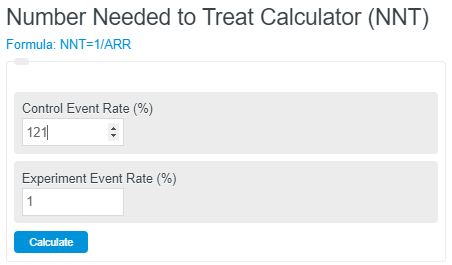Enter the control group % and the experiment group % into the NNT calculator. The calculator will display the total number of patients that need to be treated to achieve an endpoint.
Number Needed to Treat Formula
The following formula is used to calculate the total number of patients that need to be treated in order to achieve a result.
NNT=1/ARR
- Where NNT is the number of patients that need to be treated
- ARR is the absolute risk reduction
Furthermore, ARR can be calculated through the following equation.
ARR=CER - EER
- Where CER is the control event rate
- EER is the experiment event rate
Number Needed to Treat Definition
Number Needed to Treat (NNT) is a statistical measure used in clinical research to quantify the effectiveness of a medical intervention or treatment. It represents the number of patients who need to be treated to prevent one additional outcome of interest, such as an adverse event or a specific health outcome.
NNT is calculated by comparing the outcome rates in two groups: the treatment group and the control group. The difference in the outcome rates between the two groups is then used to determine the NNT.
A lower NNT indicates a more effective treatment, as fewer patients need to be treated to achieve the desired outcome.
How to calculate number needed to treat?
How to calculate a number needed to treat?
- First, measure the control event rate
This will be the percent treated in the control event.
- Next, measure the experiment event rate
This will be the percent treated in the experiment.
- Lastly, calculate the NNT
Using the formula above and the information from steps 1-2 to calculate the NNT
FAQ
What does Absolute Risk Reduction (ARR) mean in the context of NNT calculations?
ARR refers to the difference in risk between the control group and the experimental group. It is a crucial component in calculating the NNT, as it helps determine the effectiveness of a treatment by showing how much the treatment reduces the risk of a certain outcome compared to a control.
How does the control event rate (CER) affect the NNT?
The control event rate (CER) represents the proportion of participants in the control group who experience a specific outcome. A higher CER means that the outcome is more common in the absence of the treatment, which can lead to a lower NNT if the treatment is effective, indicating the treatment’s potential significance in preventing the outcome.
Why is a lower NNT considered better in clinical research?
A lower NNT indicates that fewer patients need to be treated to prevent one additional adverse event or achieve one additional positive health outcome. This suggests that the treatment is more effective, making it potentially more beneficial and cost-effective in clinical settings.
Can the NNT vary between different populations or diseases?
Yes, the NNT can vary significantly between different populations or diseases due to variations in baseline risk, the effectiveness of the treatment in different subgroups, and other factors like age, comorbidities, and genetic predispositions. Therefore, NNT should always be interpreted within the context of the specific population and condition being studied.

